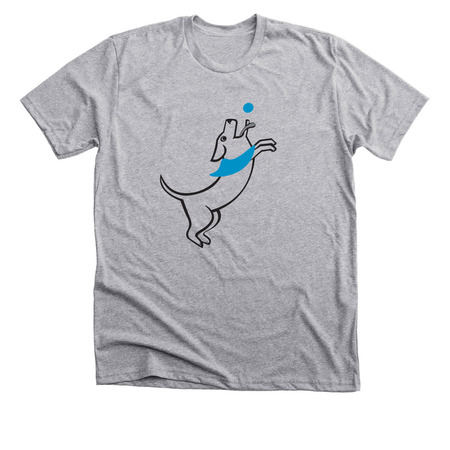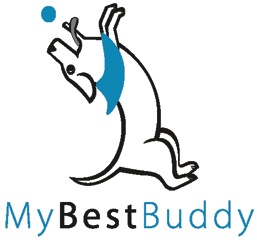Adolescence - A dog leaves puppy hood and enters
adolescence at about the age of 6 months. The dog stays an adolescent until age
2 or 3 years. The most challenging age is usually between 6 to 18 months (which
is when most dogs are surrendered to shelters). Some dogs pass through the
phase with little trouble, but most drive their guardians crazy! During this
phase it can be hard to see the light at the end of the tunnel. Adolescent dogs
have an insatiable curiosity about the world, which they explore through all
their senses, including taste. They have no idea what things are supposed to
look like or how much they cost. They don't know what cars can do to them or
that people on bicycles are really people - to the dog they can be moving
objects to be chased and nipped.
Aversive training - The use of an unpleasant stimulus
to modify a dog’s behavior. Examples:
pinch collar, choke collar, prong collar, jabbing, alpha rolling,
yelling, spanking, spray bottles, shaking a can of coins, etc. The use of
aversive techniques is less effective than the use of positive reinforcement.
The risk of emotional and physical damage is great.
Bite Inhibition – Bite inhibition refers to a dog's
ability to control the force of his mouthing/bite. A puppy or dog who has not
learned bite inhibition with people does not recognize the sensitivity of human
skin, and so he bites too hard, even in play.
Puppies usually learn bite inhibition during play with other puppies. We also teach it in the first few weeks of
puppy class.
Conditioned Emotional Response (CER) - An emotional
response a dog experiences that results from an exposure to something. It can be good (Positive CER) or bad
(Negative CER) We want dogs to have good CERs about situations, people, and
other dogs. A good CER is the goal of counter conditioning. Neutral response can be acceptable too.
Negative/bad CERs are worrisome and are at the root of many behavioral
problems. We want puppies to have lots
of positive CERs during their growing period.
Counter Conditioning -
Also called “Pavlovian Conditioning” because Pavlov discovered it. Remember “Pavlov’s dogs”? It is learning by association, where one thing
predicts another thing and produces a conditioned emotional response
(CER). In dog training, we use counter
conditioning to create good emotional responses to known triggers. We also use
it to get rid of bad emotional responses. This happens by repeatedly pairing
the stimuli with something pleasant or valuable to the dog.
Duration, Distance, Distractions – This is how we
train behaviors and make them “stick”! First, teach the behavior without any
distractions! Then, gradually increase the time (duration) still without
distractions. Gradually add in distance/distractions - starting with short distance
and minor distractions. Then, combine difficulty, distance, and distractions
together. Do not move to the next step until the last step has been mastered.
If your dog has trouble with any of the steps, go back to the previous step.
Fading out the reinforcement – This means you
systematically remove the training tool (food reward, toy reward) from a
behavior. It is the process of transferring responsibility from you controlling
the dog to your dog controlling himself. We do not want our dogs to be dependent
on the tools. Thus, we fade out the food rewards as soon as a behavior is
reliable. Keeping in mind, it takes
about two years for a dog to be fully trained.
Never rush to get rid of the food rewards.

ExPen/Exercise Pen - Like a dog crate, but no top -
they serve as a way to contain your dog. They give your dog plenty of space to
move around and play. Most dog exercise pens are made of connecting panels that
can be set up for use and then folded for storage. We recommend them for short term, supervised
confinement in your home as puppies cannot have full run of the house until
they are housetrained and have gotten through the chewing stage. We do not recommend them for unsupervised
containment. Crates are better for that.
Flooding - Flooding is a technique used to force dogs
to be in the proximity of something that they are afraid of. Many trainers
incorrectly use it without an understanding of how negatively it effects dogs.
Eileen Anderson wrote a wonderful blog, that is worth the read: Sink or Swim,
8 Ways You Might Be Flooding Your Dog. What happens after a dog has been
flooded: the stress of being forced into a scary situation builds up to a point
where they may lash out. A flooded dog
may lash out, or they may shut down, which some interpret as “calm
submissive’. But there is nothing calm
about it. Signs your dog has been
flooded: disengage from you, look away,
lie in a corner, hide, shake and tremble, pant, lip lick, whale eye (whites of
the eyes showing), paw lift, pacing, rounded body, tail tucked, frantic
barking.
Generalization/Generalizing – This means a dog becomes
able to perform behaviors and understands those behaviors in a variety of
contexts and environments (not just at your home). Dogs are not naturally very
good at this. After your dog has moved
past initial learning in your house, you want to quickly help him/her
generalize to other environments and contexts. You want your dog to be able to
sit/stay/leave it/walk on leash at places other than at home. This should be
done slowly and methodically. Train your
dog other places than at home for them to be able to apply those skills you
have taught.
High, Medium, Low Value Treats – We recommend carrying
low, medium and high value treats in your bait bag aka training pouch. Low value:
kibble . Medium value: biscuit
style treats like Crunchy O’s or Charlee Bears.
High Value: soft and stinky
treats such as a jerky style or dehydrated meat.
Learned Helplessness - This occurs when a dog feels
totally helpless to avoid negative situations. It usually happens after the dog
has been flooded (see above). This is fallout from punishment training and/or
overuse of aversive training tools like choke chains, pinch collars, shock
collars, etc. If you are unclear or are
weak in your communication with your dog, this can also result in learned
helplessness – your dog just gives up and walks off or stands there looking at
you. The dog thinks “there’s no way to shut off the negative experience and so
I will nothing at all”.
Lure-Reward Training Method- Invented by Dr. Ian
Dunbar and what we mostly use in training at MBB. Lure-Reward Training
follows the ABC pattern: Antecedent, Behavior, Consequence or more simply RRR:
Request, Response, Reward. This is the science of dog training! Lure Reward Training
is a 1234 process no matter what you’re trying to teach in this manner: 1:
Request, 2: Lure, 3: Response,
4: Reward. The lure is a piece of
food or can be a toy if that motivates your dog. We phase out the lure once the dog has
learned the behavior we are teaching.
Management – This is all the things we do with our
dogs to prevent annoying or destructive behaviors. It is important to block
these behaviors without damaging their motivation.
We set up the environment so a dog can
succeed.
It’s called puppy proofing your
house!
Mark and Pay (Pay) - A Marker Word is any sound
you will use to tell your dog when he/she did something right. We say the word “yes”, which means you got it
right and I am going to “pay” you with a reward. It is the first thing you should teach your
dog and even though sometimes we "think" our dogs know what we are
saying, it is very important to actively train this special word. Some people say “good dog” and others use a
clicker as the marker.
Positive Reinforcement - The addition of a pleasant
stimulus to increase the frequency of a desirable behavior. Essentially, it is
reward-based training.
Proofing a Behavior – Proofing, in dog training, means
practicing a behavior you taught your dog in different environments and
situations, until your dog generalizes that desired behavior and can do it
anywhere, even with distractions.
Socialization - Allowing a dog to experience the world
including places, people, things, new stimuli, and novel experiences in a positive
way to ensure confidence and stability. Socialization is most important for
puppies. For adolescent and adult dogs, socialization is also important, but
becomes more challenging as developmental deadlines pass by.
Under-socialization in puppies is one of the most common causes of future
behavior problems in dogs.
Threshold - A dog’s tolerance for certain things such as pain,
stimulation, time, and proximity to triggers. It is the boundary line from
where a dog can maintain composure to where they “lose it” You always want to
work below threshold. Build skills/behaviors in a neutral environment, and then
build on it.

Like Us on Facebook
Follow on Twitter





















